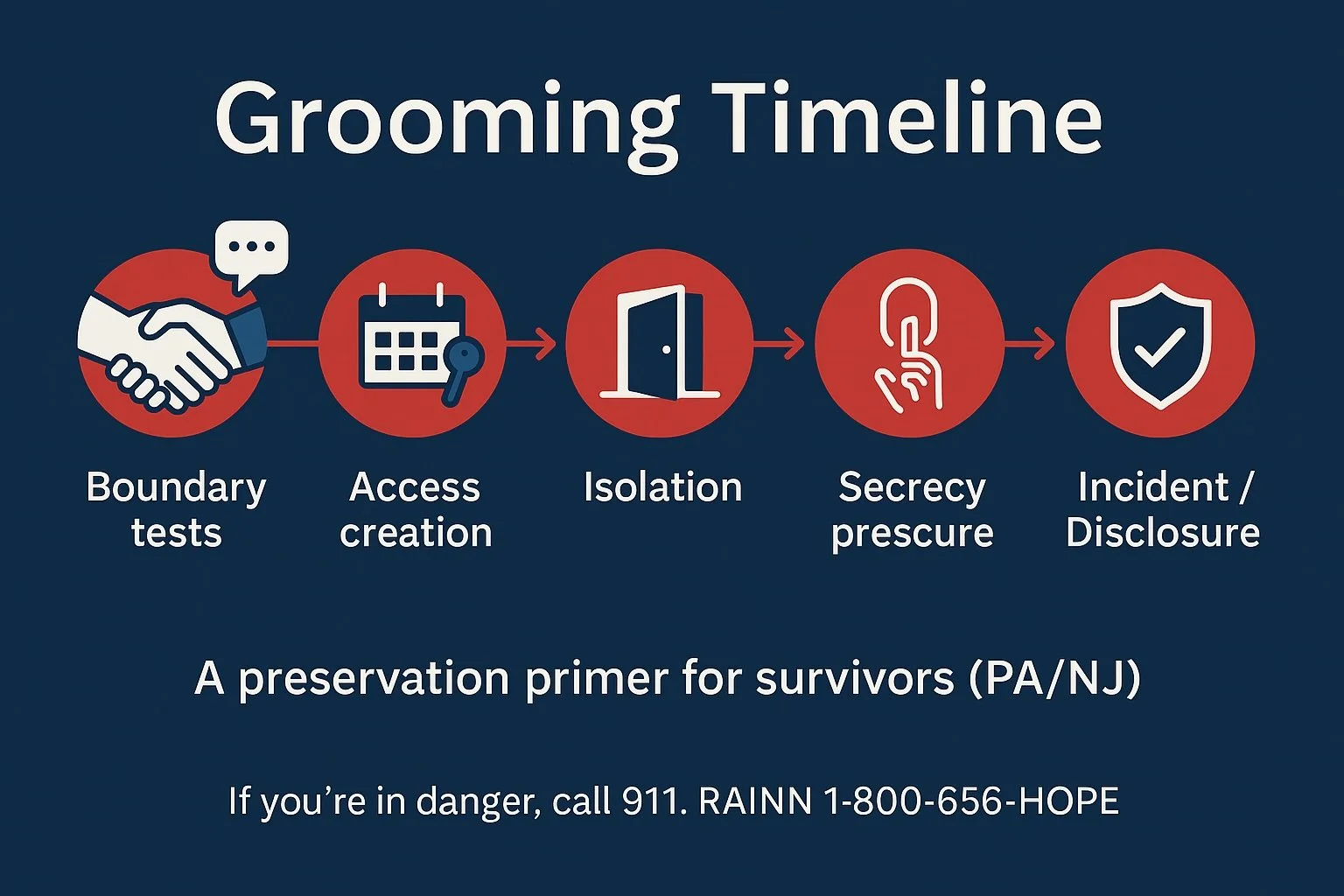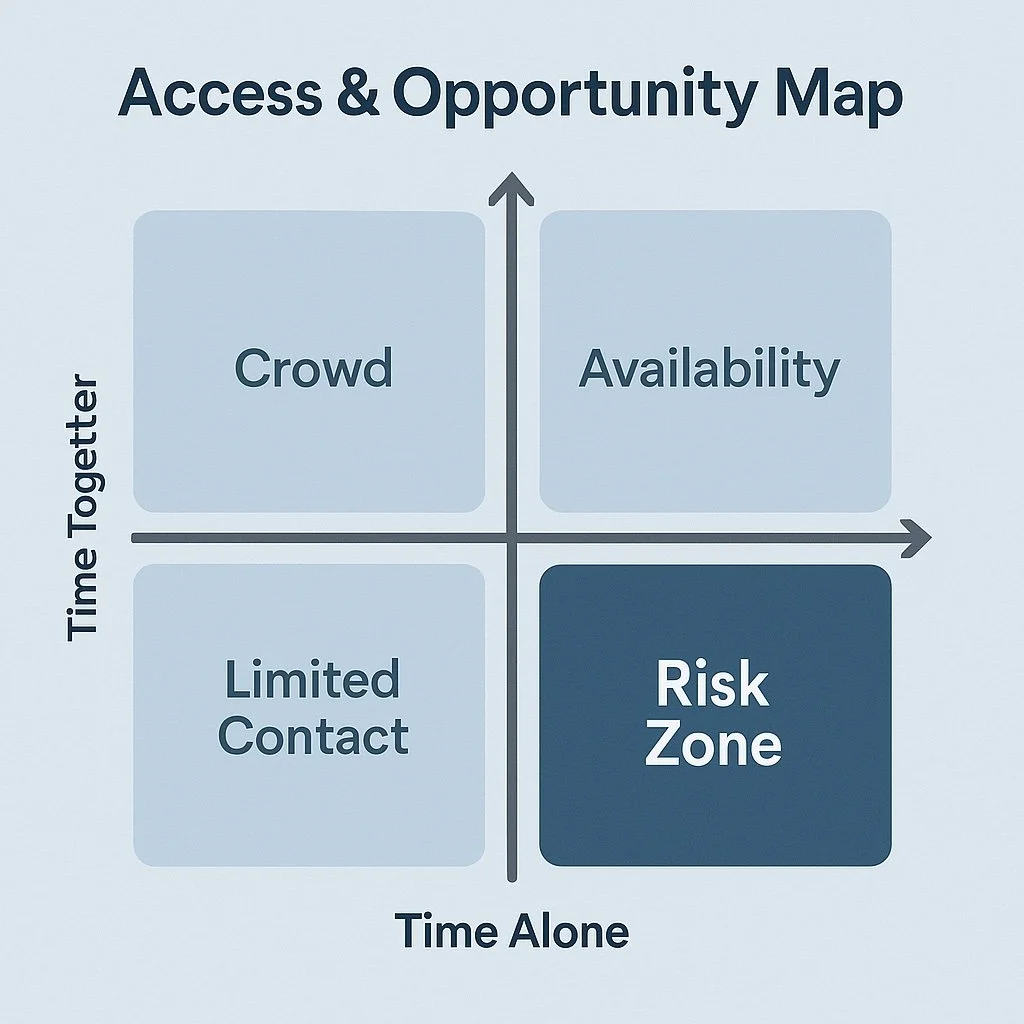Grooming Patterns as Evidence — A Preservation Primer for Survivors
Grooming is a repeatable pattern—boundary testing, isolation, secrecy, favors, and manufactured “special access.” In civil court, that pattern can prove opportunity, control, and that an institution should have foreseen the harm. This guide explains what grooming looks like, how to map access, how to document foreseeability, and exactly what to preserve now.
What “Grooming” Looks Like
Boundary tests: “special” nicknames, private messages, one-on-one rides, late-night check-ins.
Access creation: volunteer roles, tutoring, coaching, extra practices, “mentoring” outside normal hours.
Secrecy pressure: “Don’t tell,” “They won’t understand,” gifts with strings attached.
Isolation: separating the survivor from peers/family; escalating time alone.
These steps are not your fault. In a lawsuit, they’re evidence of a plan.
Access & Opportunity Mapping (turn daily schedules into proof)
We convert daily life into a simple map that shows who had access, when, and where:
Calendars & rosters: practices, study sessions, rehearsals, youth group events, aftercare sign-ins.
Duty logs: who was assigned to supervise; who actually showed up; last seen/first seen times.
Messages & ride logs: texts/DMs arranging meetings or transportation; ride-share receipts.
Building data: sign-in sheets, key-card swipes, camera locations and retention windows.
Goal: show repeated opportunities, not a single moment.
Foreseeability Proofs (what institutions “should have known”)
Prior concerns: emails/texts from parents or staff about boundary violations (private tutoring, closed-door meetings, “favorites”).
Policy vs. practice: two-adult rules, open-door rules, and reporting duties on paper—but impossible to follow in real schedules.
Ratios & coverage: not enough adults for the number of kids; predictable blind spots.
Missed escalation: complaints that went nowhere; “handled internally” without reporting.
Foreseeability means the warning signs were there—and ignored.
What to Preserve Today (no edits, originals matter)
I. Digital:
Full message threads (export + screenshots) with names, timestamps, and overlapping captures.
Emails (save as .eml or .msg + PDF).
Social media posts/DMs (export archive if available).
II. Paper & physical:
Program schedules, rosters, permission slips, duty assignments.
Notes, cards, gifts (photograph and store).
Photos of locations where time alone occurred (doors, sightlines).
III. Third-party sources:
Ask the organization to preserve video, sign-in logs, duty rosters, and emails now (see short template below).
Note typical camera retention (often days/weeks).
A. Do: save first, organize second.
B. Don’t: edit, crop, or filter originals; don’t post details online.
Your First 72 Hours After Disclosure
Safety & care first. Medical and therapeutic support; keep discharge/visit paperwork.
Write a simple timeline. Who/what/where/when; add names and contact info if you have them.
Send preservation notice. Lock down video/logs before they overwrite.
Consider reporting options. Criminal, child-protection, Title IX/school—your choice; we can explain paths.
Talk with counsel. One call can protect privacy and guide next steps.
(If anyone is in immediate danger: call 911. Confidential support: RAINN 1-800-656-HOPE.)
How We Use Grooming Evidence in Civil Court
Pattern narrative: connect boundary tests → isolated access → assault → secrecy.
Access map: calendars, rosters, messages, and building data prove repeated opportunity.
Foreseeability package: earlier complaints + policy gaps + impossible ratios.
Damages: trauma care, life-care planning, lost education/work, and non-economic harm.
Protective orders: keep sensitive records private while still telling the truth clearly.
Questions About Grooming Prevention & Recognition?
We Have Answers:
-
Answer: No. Civil and criminal paths are separate. Civil cases focus on accountability and compensation; we can coordinate with any criminal process when helpful.
-
Answer: Possibly. Time limits vary and may change based on age and location. We’ll review current rules and any revival/extension laws that could apply.
-
Answer: Many cases succeed without them. Calendars, rosters, witness accounts, emails, and institutional records can prove access, opportunity, and foreseeability.
-
Answer: Courts may allow initials or protective orders in sensitive matters. We’ll discuss privacy options and tailor filings accordingly.
-
Answer: Not at the beginning. Most steps are on paper. If testimony becomes necessary, we’ll prepare you carefully and request trauma-informed accommodations.
-
Answer: We typically use contingency agreements—no fee unless we recover—plus cost planning that won’t surprise you. We’ll explain options before you decide.
Take Action Today!
If you’re exploring your options after an injury, we are here to help you secure crucial evidence, clearly explain the possible paths forward, and protect your privacy—always working calmly and respectfully according to your timeline.
Edelstein Law • www.edelsteinlaw.com • (215) 893-9311 • Serving Pennsylvania and New Jersey – All Counties Welcome
Disclaimer: Information only; not legal advice. Viewing this page or contacting Edelstein Law does not create an attorney–client relationship. Do not send confidential information or PHI until we confirm representation in a signed engagement agreement. Attorney advertising. Past results do not guarantee a similar outcome. PA and NJ focus; deadlines apply.





